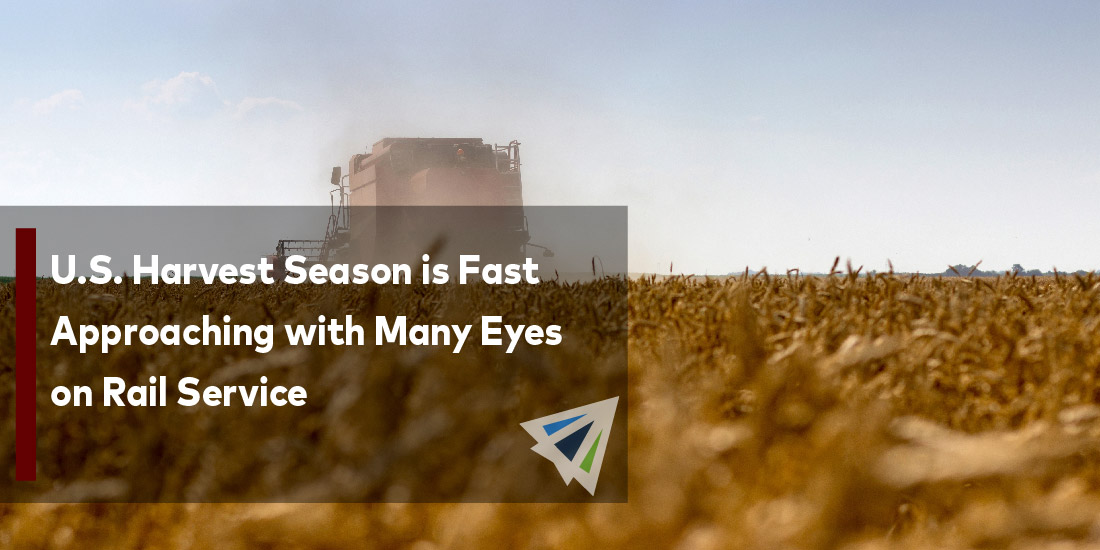U.S. Harvest Season is Fast Approaching with Many Eyes on Rail Service
It’s that time of the year where U.S. harvest season is fast approaching. Grain producers and other stakeholders have their eyes on rail service during this year’s harvest season.
Their uncertainty is met with some validity though, as rail service this year has had its fair share of challenges, specifically out on the U.S. West Coast. One of the main issues has been railcars being used as storage for shippers’ goods, rather than moving that cargo into their own warehouses.
We take a look at how U.S. harvest season is beginning and the rails’ ability to handle this year’s harvest season.
U.S. Harvest Season is Ramping Up
Typically, U.S. harvest season begins in early August, and then the season keeps picking up as more areas are ready for harvesting. As FreightWaves notes, the peak of harvest season occurs as harvests move northward in late September and continue throughout October and November – which is also when demand for rail service grows stronger.
Max Fisher, Chief Economist and Treasurer for the National Grain and Feed Association points out that this year’s harvest is anticipated to vary by region. The Central and Southern Plains experienced a lot of drought this year. What that means is that in those regions, grain production is likely to be lower than normal, he states.
Fisher notes that the heart of the Corn Belt should see a normal harvest. What’s the Corn Belt you ask? The Corn Belt is a region in the Midwest that produces an excessive amount of the nation’s corn, according to Business Insider. This region goes from parts of Ohio to parts of Kansas, Nebraska, the Dakotas, parts of Minnesota and Missouri and Kentucky.
Rails’ Ability to Handle U.S. Harvest Season
Near the end of August, the Surface Transportation Board (STB) sent a letter to all seven Class I railroads asking for details on how the railroads expect to meet the rail demand for this harvest season.
The STB is also asking for information from the railroads on how they expect to meet market demand for grain and grain products and what they plan is to maintain network fluidity throughout main corridors, FreightWaves reports. The STB is very focused on whether railroads will have sufficient crew, locomotive, equipment and capacity resources that focus on supporting domestic and international markets.
Earlier this year, the STB asked the Class I railroads to submit weekly reports detailing a variety of information including headcount levels for train and engine crews, as well as data that documents service data for on-time performance of railcars arriving at their final destinations.
Fisher points out that while some areas in the U.S. may be seeing rail service improve, other areas may still be experiencing frustration with rail service, it’s not a one size fit all sort of situation. One region that depends extensively on rail is the Pacific Northwest, where exports of grain heads out of.
Many in the industry feel like there’s a lot riding on the supply chain to be able to accommodate the anticipated solid volume of grain exports. For example, one soybean meal shipper anticipates a 10-day round-trip journey between his production facility in the Midwest to the Pacific Northwest. That journey translates into three turns of a rail car per month – but if rail service delays occur and result in a longer journey, that can decrease the number of turns that a car can make, as FreightWaves reports.
Looking Ahead
It remains to be seen how this year’s U.S. harvest season will go. Of course, it will have its challenges, but many stakeholders still remain optimistic.
As always, if you would like more information regarding this topic, contact our team at InterlogUSA and we will be happy to assist you on any questions or comments you may have! In addition, we have our weekly market updates that provides relevant freight news, updates, and developments across the industry.
